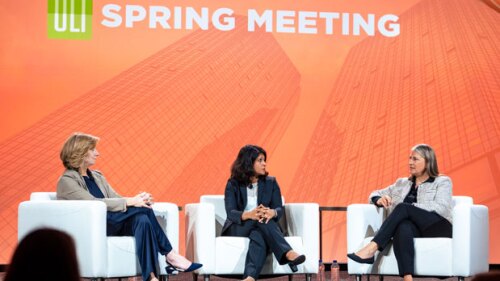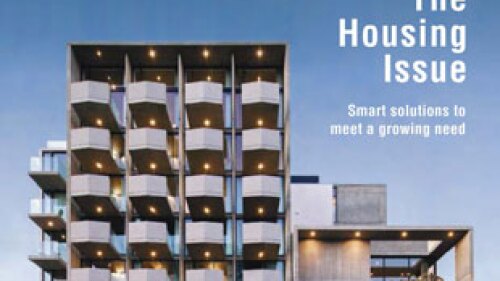New partnership models, coupled with greatly expanded private sector involvement, will be needed if cities are to build the urban transit infrastructure that is in high demand across the country, experts said during a panel at ULI’s Spring Council Forum in Phoenix, Arizona.
Dennis Allen, a Los Angeles developer and director of Los Angeles Streetcar Inc., and A.C. Gonzales, assistant city manager for Dallas, Texas, participated in a panel moderated by David Leininger, chief financial officer of Dallas Area Rapid Transit.
Leininger opened the discussion by noting that constituents are always requesting new investment in transit, despite diminished resources. He summarized the sentiment of transit operators: “We have no funding, but we can’t stop!” As a result, he said, value capture is reemerging as a tool for funding projects, everything is more complicated than it used to be, and private companies are being asked to play an ever-increasing role in funding, building, and operating new systems.
A Transit Nonprofit in Los Angeles: Back to the Future
Allen described a new, “back to the future” approach being employed in Los Angeles, one that integrates the private sector and property owners into the development and operations of the streetcar infrastructure “the way it used to be done.”
The planned $125 million downtown streetcar system will provide connecting transit infrastructure for the extensive commuter- and heavy-rail system being built in Los Angeles with funding from Measure R, the 2008 ballot initiative, and help solve L.A.’s “last mile” problem.
Los Angeles Streetcar Inc. is a 501(c)3 nonprofit organization, governed by a board of directors, that was formed out of a partnership of downtown property owners, the city’s public transit agency, and other entities. Allen leads the organization and is also a real estate developer in Los Angeles. The organization and approach are modeled after similar efforts in Portland, Oregon, and Seattle, Washington.
Los Angeles Streetcar is taking the lead in pulling together funding for, building, and operating a streetcar system in the downtown core. For funding, the organization is spearheading efforts to persuade adjacent property owners to agree to an assessment that will pay for about half of the system’s capital costs. The transit system is expected to boost downtown property values through increased demand and retail visibility. Allen says he believes that it is only fair that adjacent property owners be asked to share in the costs associated with providing this benefit. But, he said, convincing them of that has been an uphill battle. Other funding sources will include the federal and state governments.
Once funding is secured, Los Angeles Streetcar will select the system’s designers and contractors, subject to the city’s approval, and will also contract for system operations and maintenance.
Dallas Streetcars: Forward to the Past
Gonzales noted that Dallas, an already bustling city, is expecting even more growth in the future. The city’s first comprehensive plan, forwardDallas!, laid out a vision for a higher-density and more mixed-income, mixed-use, and pedestrian-friendly city in 2006. In more recent years, streetcars have been identified as a critical missing component in the region’s transportation system, and an important element in efforts to connect people to the regional light-rail system. Ironically, Dallas once had an extensive streetcar network—its first line began service in 1872—but it hasn’t had an operational streetcar line since 1964.
Gonzales said that the city is exploring “forward to the past” approaches to building out the new network, calling land-related revenue strategies “critical” to re-creating a robust rail system. The city has already begun operating vintage streetcars in the arts district and hopes to add a 20-mile (32-km) double-tracked network, which is estimated to cost $800 million for construction alone. “Capital is only half of the battle,” he noted. The city will also need commitments for funding to operate the system.
Faced with increasingly constrained public resources, the city is turning to the private sector to fund, build, and operate the new transit systems. In the new partnerships being envisioned, the government will be the facilitator, but private sector partners will be called on to design, operate, maintain, and finance the projects, and will also be the facility owner and a full development partner with the city and regional transit authorities.
Conclusion
In Dallas and Los Angeles, local leaders are forging new partnerships and collaboration strategies in order to move forward with streetcar investments. Diminishing public revenues will mean that in these cities and elsewhere, private entities—including real estate developers—will be taking on new roles as transit funders, builders, and operators.



